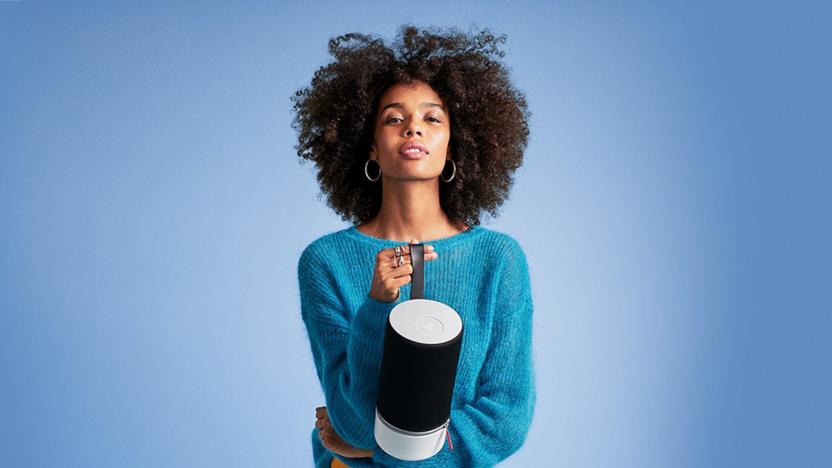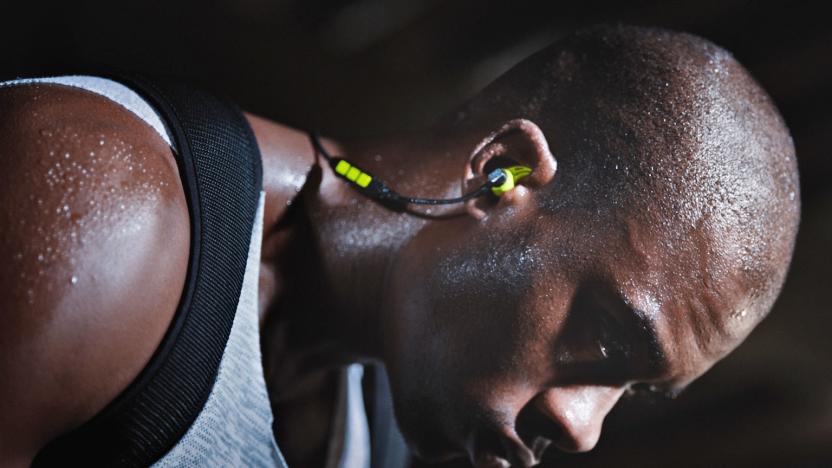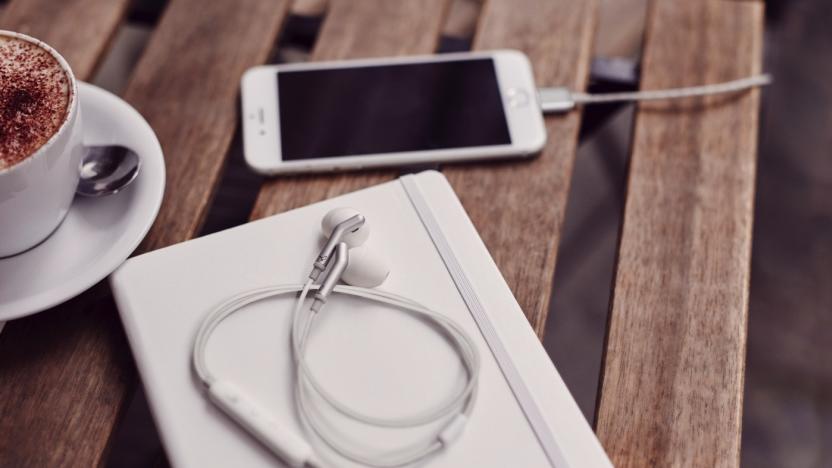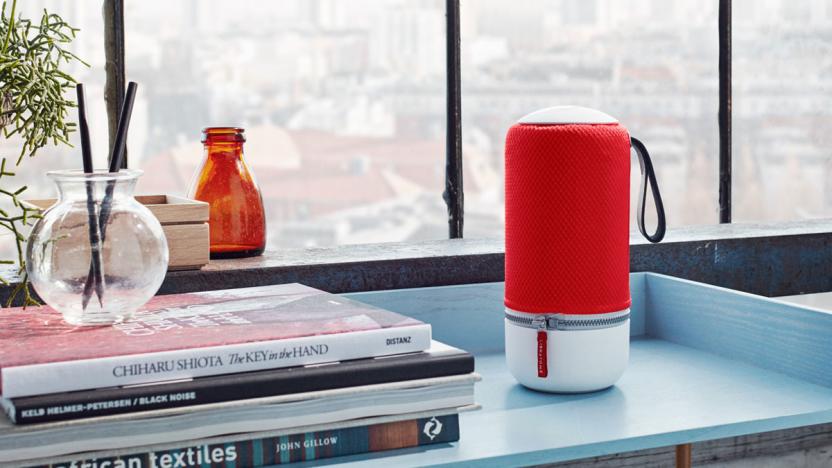Libratone
Latest

Libratone's new portable Zipp speakers come with Alexa
These days, there's no shortage of Alexa-enabled speakers, so companies have to differentiate through design and audio quality. One brand swimming in both is Libratone, which announced a new version of its Zipp and Zipp Mini speakers during IFA 2018. They offer up to 12 hours of battery life and connect over Bluetooth and WiFi -- including Spotify Connect and AirPlay 2 -- USB, and a 3.5mm mini-jack. Both ship with six microphones and, for the first time, support for Amazon's assistant, meaning you can request tunes and pizzas with your voice. Otherwise, you can control the speaker through the touchpad or companion mobile app.

Sennheiser’s latest wireless earbuds are built for the gym
Sennheiser has released its latest set of tethered, wireless headphones. The CX Sport is a splash- and sweat-resistant model with a number of comfort features. The headphones can be worn with the cable positioned behind the neck or in front and ergonomic fins, which come in three sizes, can be attached to the earbuds to make sure they stay in place. The ear adapters also come in four sizes. For added comfort control, the headphones also come with a cable organizer that lets you adjust the cable length and a clip that allows you to affix them to your clothing.

Libratone brings adjustable noise cancellation to wireless earbuds
Libratone's adjustable noise cancellation has been available for a while if you've been willing to plug in or wear over-ear cups, but what if you prefer wireless earbuds for your fitness sessions? You're set from now on. The Danish outfit has introduced Track+ Wireless In-Ear Earphones, which let you dial out external sounds while remaining relatively discreet. As with Libratone's earlier models, you have four levels of cancellation that dictate how much outside sound gets in: You can let in a lot of it if you're running outside, or shut it out entirely if you're commuting on a noisy subway car. You can also use the microphones to amplify external sound if you want to hold a conversation or listen for worrying noises without removing your buds.

Libratone's Q Adapt headphones offer adjustable noise cancellation
One of the most prevalent rumors about the new iPhone(s) is that Apple will get rid of the 3.5mm headphone jack. Unfortunately, the options for Lightning-equipped wired headphones are still limited, but Libratone has a new model that fits that description. The company is getting into mobile audio after releasing a number of speakers, but the Q Adapt headphone line's key feature is actually the ability to adjust noise cancellation based on your environment. For example, you might want to turn it down when you're walking in a busy city when you need to hear the cues from traffic.

Libratone jumps into multi-room audio with its latest speakers
Libratone isn't content with churning out more cloth-covered wireless speakers -- it wants to muscle in on Sonos' home turf. The upscale gear maker has launched both an updated Zipp speaker and a smaller Zipp Mini (shown above) that include multi-room audio. You can link as many as six of the zipper-clad speakers over WiFi, much like some of their peers. The key, as you might have guessed, is that everything is portable. If you're jonesing to move your entire setup to a new room, you can do it without feeling like you're moving house.

Libratone's got a new soundbar, and yes, it's covered in wool
If only there was a way to combine your two greatest passions: high-quality audio and soft, fluffy fabrics? Well as it turns out, Libratone is kind of a specialist in that field, and for its next wool-covered creation, the company is revisiting soundbars with the "Diva," announced today. Following on from its "Lounge" speaker of several years past, the Diva trades the square form factor for a curvier, oblong shape. And while it's supposed find a home under your big-screen TV, the idea is the Diva can be your primary sound system, rather than just an accessory. Nestled beneath its woolen coat are two 1-inch, 25W tweeters taking care of the higher end; two, 3-inch 50W mid-range speakers; and one, 5-inch 75W subwoofer dealing with bass tones. In addition to the on-board digital amplifier, that sub is also supported by two passive radiators that are meant to facilitate a richer low-end sound without increasing energy consumption or weight.

Libratone Zipp Wireless Speaker: Portable, high-end audio with good looks
The Zipp (US$399.95) is the first in Scandinavian-based Libratone's range of high-end, wireless speakers, followed by the Loop, Live and Lounge. Steve Sande took a closer look at the Loop earlier this year, and while he was impressed with the quality of sound and design, the high price point and finicky setup process were some noted drawbacks. I've spent the last week or so using the Zipp. I was keen to see how the smaller Zipp compared to Steve's take on the Loop. Design First off, the Zipp looks great. With its tall, cylindrical shape, the Zipp is unassuming and simple in appearance, yet its changeable, woolen covers (that come in multiple colors) give it personality and life. The covers are changed by unzipping the old one and zipping on a new one -- hence: the Zipp!. The Zipp's Height is 26.0 cm (10.2") and its circumference is 12.2 cm (4.8"). The Zipp weighs 4 lbs (1.8 kg). On top of the Zipp is a simple, circular button to power the device, with volume-up and volume-down buttons either side, not dissimilar to an Apple TV remote in appearance. There's a small LED light that indicates the Zipp's status; if all's well the LED fades in and out with a soft, white glow. Round the back is a leather strap to carry the Zipp from room to room or out and about. Underneath the leather strap are the Zipp's inputs (3.5mm aux-in and audio USB) as well as a WiFi and PlayDirect button and a battery status indicator. Underneath is a solid base with an input for the Zipp's power supply, a rather clunky brick. All in all, the Zipp looks great, especially with its removable cover. The Zipp's form factor means it will fit on just about any table top, counter or shelf. The only aesthetic drawback of note was the Zipp's plastic top, which feels a little, well... plasticky. Inside the Zipp is a 60W, digital amplification 2.1 stereo system. There's a 4" bass speaker and two 1" ribbon based tweeters. There's also a lithium-ion battery that promises 8 hours of wired operation or 4 hours of wireless operation. Performance Thankfully, I didn't experience the same setup issues Steve did. I opted to connect the Zipp to my home's Wi-Fi network using the Libratone Zipp app on my iPad (which first did a software update on the Zipp). Once I had the Zipp connected to my home network, the Zipp appeared on my iTunes and iOS device's AirPlay menu. It's worth noting that the Zipp can connect to your iOS or Mac via PlayDirect, where the Zipp is setup as a standalone Wi-Fi network, allowing AirPlay between the Zipp and your device without the need for a Wi-Fi network. This is a great feature, especially for a portable speaker, like the Zipp. In terms of sound, I was really thrilled with the Zipp's performance. There was a real subtlety to the Zipp, especially in the higher ranges, where detail really shone through. This made the Zipp a truly satisfying listen. Having said that, I did find the Zipp was a little lacking in terms of weight. That's not to say it didn't have a solid punch with up-beat, bass-heavy tracks, but rather, overall, the sound could do with being slightly fuller in the low-range. Even so, the Zipp is still a fantastic listen. The Acid's Animal is breathtaking, with the Zipp delivering so much rich detail. I was taken aback by the way reverb carries on different beats and vocal parts, and then when it's absent; the sheer dryness that is exposed. The decay-crunch on the sampled drum roll is glorious, and I found lost on lesser speakers. And all those little guitar hisses and ambient amp noises come through so well. It's testament to the recording, but also how well the Zipp delivers. I found AirPlay performance on the whole to be good, though I did get occasional clicking sounds every now and again, despite being in good range of my router. Wired playback was without any problems, and sounded super. Conclusion The Libratone Zipp is a solid piece of kit. It looks the part and has fantastic sound, particularly when it comes to detail. The best part is that you can unplug it and take it anywhere, thanks to its built-in battery and PlayDirect Wi-Fi. You won't get a day's life out of the battery (especially if you're using the speaker wirelessly), but you'll be getting true high-end sound, which is more than you can say for other battery-powered portable speakers. If portability isn't a priority, there are other contenders to weigh up against the Zipp, but if high-end sound and portability are at the top of your list, check out the Zipp.

Libratone's wool-wrapped speakers gain Spotify Connect streaming abilities
If you fancy picking up a track where you left off on the commute upon entering your flat, and you've splurged for a Libratone speaker, you're in luck. The company's offerings (like the Loop and Zipp) are now Spotify Connect compatible, making connecting with your mobile device a breeze. As part of the streaming service's paid subscription, the option allows direct streaming with a speaker and smartphone or tablet on the same WiFi network. Libratone's audio gadgets already packed AirPlay and other wireless options, and this one can be nabbed thanks to an update to the speaker's firmware -- accessed through the companion app. This also means another audio choice joins the likes of B&O, Sony, Samsung and others who already offer Spotify's enhanced connectivity.

Libratone Loop Wireless Speaker: AirPlay meets Scandinavian design
Last week we had a look at a very impressive Bluetooth speaker set from Edifier, the e25 Luna Eclipse. Those speakers provided both excellent sound quality and futuristic design, and ended up with a top rating from TUAW. This week I'm looking at Libratone's Loop Wireless Speaker, a high-end entry into the speaker market that marries Scandinavian good looks to AirPlay compatibility. Specifications Price: US$499.95 Colors: Salty Gray, Pepper Black, Raspberry Red, Icy Blue (extra wool covers are sold in a variety of colors) Connectivity: AirPlay and DLNA support, also supports PlayDirect for streaming directly from a device without need for a Wi-Fi router. Also includes 3.5 mm audio minijack and USB audio jack Power: 100-240 V AC, 50/60 Hz, 40 W power consumption Dimensions: Weight: Speakers: 2 x 1" ribbon-based tweeters, 5" subwoofer with resonating passive radiator Comes with wall mount and duo-stand Design Highlights Rather than a set of speakers, the Loop is just one disc-shaped speaker. I was reminded of the seat of a stool, or a target for Velcro darts. The speaker is covered in Italian wool, and there are a number of accessory wool covers you can purchase should your cat rip one to shreds or you decide to change the paint color in your home. The Loop can be wall-mounted or sit on a shelf or table. A pair of legs known as a duo-standn provide a stable platform for the latter, while the wall mount features a small truncated cone that fits into a receptacle on the back of the speaker. As you'd expect with Scandinavian design, the Loop is very stark and simple. Controls are on the back and consist of a combination power switch/status indicator/volume toggle and another set of buttons for linking the Loop to your device. I also have to hand it to Libratone for not using the typical ugly black brick as an AC adapter. Instead, the power supply is built into the Loop, and there's a single power cord -- with a soft, tangle-proof covering on it -- that connects the speaker to your outlet. Functionality Highlights Most of the Bluetooth and AirPlay speakers I test are usually quite easy to set up. Bluetooth speakers are incredibly simple, while AirPlay speakers usually require that the speaker be added to your WiFi network. That's usually done by linking to the device's own WiFi or Bluetooth transceiver, passing over some information about the network and password, and then you're done. Not so with the LIbratone Loop. First, I decided that I'd use their quick start instructions, which told me to get a USB cable and connect it. At that point, I was supposed to press two buttons on the back simultaneously to get the device to ping my iPhone to allow it to share network information. The process worked, but I could never get the speaker to connect to the network. After about a half hour of frustration, I finally did a reset (press the power button and two buttons on the back simultaneously) to get it to factory defaults. At that point, I was able to get everything set up perfectly, although it took a while for the Loop to show up in the list of AirPlay devices. Once it did, I started blasting music to it. This is a very loud speaker, with a pronounced bass end thanks to the 5-inch subwoofer. Libratone has a free app that is supposed to let you you do the setup from the iPhone or iPad, although I wasn't able to get that to work. However, the app also lets you tune the sound of the speaker for the type of surface it's sitting on and the type of music that is playing. This is a very useful app from the sound adjustment standpoint -- I was able to move from house music to jazz to classic rock, adjusting the equalization for each with preset voicing that made the sound perfect for each type of music. All in all, I found it the Loop to be a very enjoyable speaker to listen to, although the setup left something to be desired. My guess is that this speaker had been previously set up for another reviewer and that I should have done the factory reset first. Conclusion The Libratone Loop is definitely an audiophile speaker, with a price tag to match. The setup process could be better, but the design and sound of the speaker as well as the ability to match the sound profile of the speaker to the type of music you're listening to and the surface upon which it's sitting make this one of the most adjustable AirPlay speakers I've tested. Rating: 3-1/2 stars out of 4 stars possible

Libratone's $500 Loop speaker wraps AirPlay, PlayDirect and DLNA in wool
Don't quite have the funds -- or room -- for the circular B&O Play A9 speaker ($2,700)? Libratone's new AirPlay and DLNA-equipped Loop might catch your eye. The $500 satellite dish-like rig packs two ribbon tweeters and a bass radiator, which together pump out enough volume for moderately sized rooms. While the Loop is tiny enough to sit on a nightstand, it also comes with a detachable wall mount. You can even connect devices to it via ad-hoc WiFi if you're away from an actual network, thanks to PlayDirect -- just like the Zipp. As with all Libratone speakers, the unit's sound characteristics are adjustable via a free app (Android and iOS) and the swappable wool speaker grille comes in a variety of colors ($50 each). The Loop is up for pre-order now in "Pepper Black, "Salty Grey" and "Raspberry Red" if you're interested enough to bring it full circle. It'll hit doorsteps and retailers by the end of the month.

Libratone speakers get an Android app to call their own
Libratone's speaker line hasn't been convenient at all for mobile users who don't swing the iOS way -- not unless they've got a very long audio cable. The audio designer hasn't quite achieved the Holy Grail of full wireless control for other platforms, but its new Android app provides the next best thing. The release lets Android 2.3 and beyond set up Live, Lounge and Zipp speakers on the WiFi network, and it can tune their sounds to match a physical space or musical tastes. There's still a distance to go when the speaker needs an aux-in connection just to change the volume. Still, we'll take a free app if it saves us a few walks across the living room.

Libratone intros Zipp portable AirPlay speaker with PlayDirect, expectedly wrapped in wool (update)
If you've been following the surge of AirPlay speakers that started hitting the market in 2011, you've likely feasted your eyes on the spendy wool-clad systems by Libratone. While its larger Live and Lounge units have primarily been purposed for households, its new Zipp speaker is the being touted as the "first and only" portable AirPlay speaker. Make no mistake, unlike B&O Play's portable AirPlay-equipped Beolit 12 ($800), the Zipp's loaded with Libratone's proprietary PlayDirect protocol, meaning it doesn't require a separate wireless network / router for iDevices to connect to it over the air. The Zipp moniker is a play on the swappable wool grill which cozies around its vertically-standing tubular enclosures. Weighing four pounds and measuring in at 10.2 inches high by 4.8 inches in diameter, this "portable" unit is a good bit larger than the Blutooth-equipped Jawbone Big Jambox placed sideways, but it'll certainly fit in a backpack -- hey, it does have a leather carrying strap. Thankfully, that weight is partially due to its internal rechargeable battery, which should last up to eight hours. As far as the speakers go, you'll find a duo of 1-inch ribbon tweeters facing the sides for the left and right channels, along with a 4-inch up-firing woofer. The rig also features Libratone's signature FullRoom design, which forces a 360-degree dispersion of the sound by way of deflectors in front of the tweeters. Beyond that, it'll naturally work with Libratone's existing iPhone app, allowing you to change the DSP on the fly for optimal output regardless of its placement in a room. The Zipp will hit Apple Stores later this October wrapped with a single red or grey zippered grill for $399, while other retailers will carry the $449 Classic Color and Funky Color editions, which each come with a trio of those wool grills (black, blue and red for the Classic, and black, pink and yellow for the Funky). Past that, a single grill by itself will cost you a relatively expensive $49 directly from Libratone. In the meantime, join us past the break for more details about the unit itself and PlayDirect, our initial impressions and a hands-on video overview.

Libratone Live and Lounge AirPlay speakers now available in the US
Libratone managed to pique our interest with its brightly-colored, cashmere-ensconced Live and Lounge AirPlay speakers this summer, and it's now finally announced that they're both available in the US. They come in at an expectedly hefty $699 for the smaller Live model and $1,299 for the larger Lounge soundbar (add an extra $100 to each for that aforementioned cashmere option -- yes, really), and they'll both be available at Apple stores and other select design retailers. Despite that sizable price difference, both units have the same 150W of total output power (coming from five dedicated amplifiers), although the Lounge promises some expanded range that's better suited for a living room -- it's also much bigger than it appears in the not-to-scale image above (40 inches wide, to be specific, while the Live is just under eight). The official press release is after the break.

Libratone's AirPlay-enabled soundbars want to cozy up with your iOS wares
Been on the prowl for an audio solution with AirPlay to compliment your iDevice or Apple TV? Bid hello to Libratone's ultra-chic Lounge and Live soundbars. Last year, the company introduced its eye-catching Beat wireless speaker system back at IFA; we were intrigued by its active drivers and carry handle, but mildly disappointed that cord-cutting required pesky proprietary adapters. Apple users will be happy to know AirPlay's been fully embraced this time, along with the signature adornment of cashmere wool. First up, the Live appears to be an Airplay-enabled Beat with 50 extra watts of RMS power (150 total), and an updated -- mini TOSlink accepting -- 3.5mm input for hooking up non AirPlay-enabled gear. Next up, the sleek Lounge unit above sports a similar external design and digital 3.5mm jack, but it's svelte in comparison for wall-mounting under a TV. Under its sheep fuzz, you'll find two 1-inch ribbon tweeters, two 4-inch ceramic drivers, and one 8-inch inverted woofer, all of which are independently amplified for a combined output of 150 RMS watts. Poised to please audio enthusiasts, both employ DSP and Libratone's FullRoom for a "360 degree soundscape" controllable via an iOS app, while the Lounge's volume can also be handled by a TV remote. The Lounge will be available through Apple's online store this September priced at £1,099 to €,1199 (about $1,791 to $1,954), and the Live for £599 to £6,99 ($699) at Apple retail locations in the EU and US -- both in various colorways. You'll find details in the PR after the break while your next bout of Gear Acquisition Syndrome begins settling in.

Libratone Beats wireless speakers begin playing when you enter the room
We're suckers for wireless speakers, but they have to work. We're not the least bit interested in streaming technologies that stutter from interference or compress the audio to preserve bandwidth. That's why Libratone caught our attention here in Berlin with its new Libratone Beat -- the "world's first high-end active speaker with wireless technology," or so they claim. The speaker features one 5-inch bass, two 3-inch midrange drivers, and two 1-inch ribbon based tweeters. In all we're looking at 50W of bass output and 2x25W at the tweeter / midrange. There's even a 3.5-mm mini jack to tether devices. The big question here is will they be worth the MSRP €595 / $655 when they start shipping across Europe and the US in January? Well, we can't say for sure. After all, we could only listen to the speaker on the very crowded (and noisy) floor of the IFA trade show. But what we heard sounded decent and did manage to stream audio over its proprietary transmission technology even at a distance of about 50 feet. Very impressive considering the high concentration of WiFi hotspots and other wireless devices in use within just a few feet of the Libratone booth. Here's the catch: a dongle is required to communicate with the speaker -- a small version for the iPod / iPhone / Pad or a larger USB stick for your laptop -- both included with the purchase price. On the plus side, multiple Beats can play at once -- just wander into range of one or multiple Beats and they'll start (and later stop) playing automatically. Nice. Update: We've added a second gallery of press images below. %Gallery-101388% %Gallery-103235%








